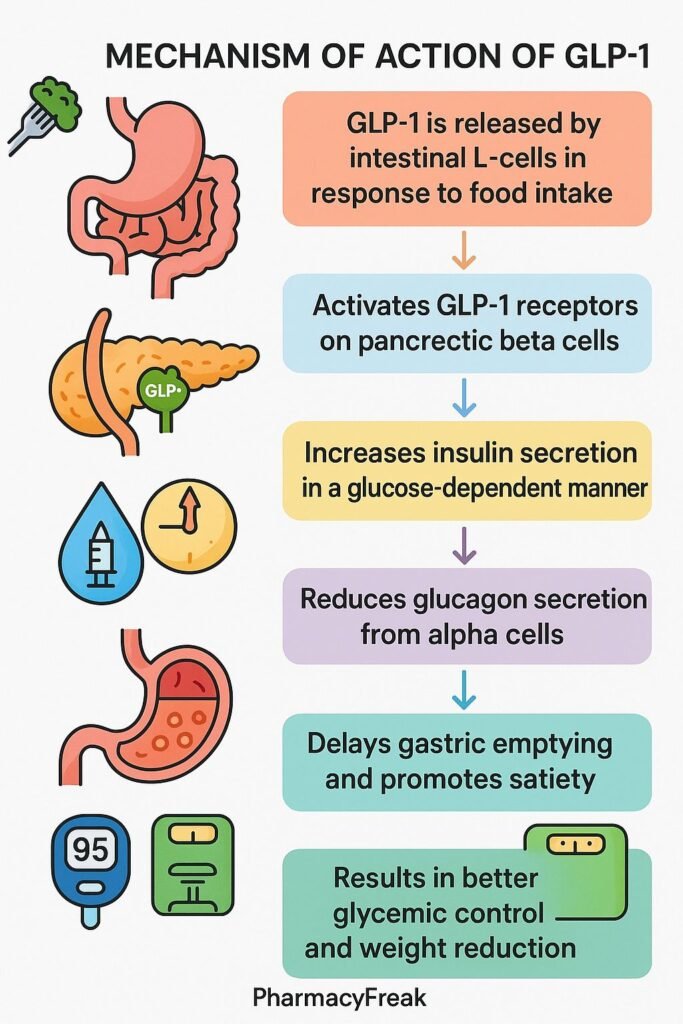Table of Contents
Introduction
Glucagon-like peptide-1 (GLP-1) is an endogenous incretin hormone secreted from the L-cells of the distal ileum and colon in response to food intake. It plays a critical role in regulating glucose homeostasis and energy balance. GLP-1 acts through specific receptors found in the pancreas, gastrointestinal tract, and central nervous system to modulate insulin secretion, suppress glucagon, and slow gastric emptying.
Step-by-Step Mechanism of Action
- Secretion from Intestinal L-cells
GLP-1 is released postprandially from enteroendocrine L-cells in the ileum and colon in response to nutrient ingestion. - Binding to GLP-1 Receptors
It binds to GLP-1 receptors (GLP-1Rs), which are G-protein-coupled receptors found predominantly in pancreatic beta cells, as well as in alpha cells, the brain, and gastrointestinal tract. - Enhancement of Glucose-Dependent Insulin Secretion
In pancreatic beta cells, GLP-1 increases cyclic AMP (cAMP) levels, activating protein kinase A (PKA) and Epac2 pathways to enhance insulin secretion in a glucose-dependent manner. - Suppression of Glucagon Secretion
GLP-1 inhibits glucagon release from pancreatic alpha cells during hyperglycemic states, reducing hepatic glucose output. - Slowing of Gastric Emptying
It delays gastric emptying, prolonging nutrient absorption time and attenuating postprandial blood glucose rise. - Appetite Suppression and Satiety
GLP-1 acts on the hypothalamus to suppress appetite, enhancing satiety and reducing caloric intake. - Short Half-Life
Native GLP-1 has a very short half-life (1–2 minutes) due to rapid degradation by dipeptidyl peptidase-4 (DPP-4) enzyme.

Pharmacokinetic Parameters
| Parameter | Value |
|---|---|
| Source | Intestinal L-cells |
| Half-life | 1–2 minutes |
| Degradation | By DPP-4 enzyme |
| Receptor Type | G-protein-coupled (GLP-1R) |
| Main Sites of Action | Pancreas, GI tract, brain |
Clinical Uses (Physiological Role)
- Regulation of postprandial glucose levels
- Enhancing glucose-stimulated insulin release
- Reducing glucagon secretion during hyperglycemia
- Slowing gastric emptying
- Promoting satiety and reducing food intake
Adverse Effects (when mimicked pharmacologically)
- Nausea and vomiting
- Delayed gastric emptying
- Rare pancreatitis (in GLP-1 analog therapy)
- Injection site reactions (from analogs)
Comparative Analysis
| Hormone | Stimulates Insulin | Suppresses Glucagon | Slows Gastric Emptying | Origin |
|---|---|---|---|---|
| GLP-1 | Yes | Yes | Yes | Intestinal L-cells |
| GIP | Yes | No | No | K-cells of duodenum |
| Glucagon | No | N/A | No | Pancreatic alpha cells |
MCQs
- GLP-1 is secreted from which type of cells?
a) Alpha cells b) Beta cells c) L-cells d) K-cells
Answer: c) L-cells - GLP-1 secretion is stimulated by:
a) Fasting b) Stress c) Food intake d) Exercise
Answer: c) Food intake - One major function of GLP-1 is to:
a) Increase glucagon b) Inhibit insulin c) Stimulate glucose-dependent insulin release d) Stimulate lipolysis
Answer: c) Stimulate glucose-dependent insulin release - GLP-1 slows:
a) Hepatic metabolism b) Gastric emptying c) Renal excretion d) CNS transmission
Answer: b) Gastric emptying - The enzyme that rapidly degrades GLP-1 is:
a) MAO-B b) COMT c) DPP-4 d) PKA
Answer: c) DPP-4 - Which of the following is a central effect of GLP-1?
a) Hypothermia b) Appetite suppression c) Anxiety d) Euphoria
Answer: b) Appetite suppression - GLP-1 acts via which type of receptor?
a) Tyrosine kinase b) Ligand-gated ion channel c) GPCR d) Nuclear receptor
Answer: c) GPCR - GLP-1 does not significantly act on:
a) Pancreas b) Brain c) Gastrointestinal tract d) Skeletal muscle
Answer: d) Skeletal muscle - GLP-1 enhances insulin secretion via:
a) PIP2 pathway b) IP3/Ca2+ c) cAMP/PKA d) JAK/STAT
Answer: c) cAMP/PKA - Native GLP-1 has a half-life of:
a) 1–2 minutes b) 10–15 minutes c) 30–60 minutes d) >2 hours
Answer: a) 1–2 minutes
FAQs
1. What triggers GLP-1 release?
GLP-1 is secreted in response to carbohydrate, fat, and protein ingestion.
2. Does GLP-1 cause hypoglycemia?
No, it enhances insulin secretion only in the presence of elevated blood glucose.
3. Why is GLP-1 rapidly inactivated?
It is quickly degraded by DPP-4, limiting its physiological duration of action.
4. How does GLP-1 affect appetite?
It promotes satiety by acting on the hypothalamus, reducing food intake.
5. Is GLP-1 used directly as a drug?
No, due to its short half-life. Long-acting GLP-1 receptor agonists are used instead.
References
- PubMed: Physiology of GLP-1
- DrugBank: GLP-1 biological role
- NCBI Bookshelf: Incretin hormones overview
- StatPearls: GLP-1 physiology
- [Textbook: Goodman & Gilman’s The Pharmacological Basis of Therapeutics, 13th ed.]

I am pursuing MBA in pharmaceutical management from NIPER Hyderabad with a strong academic record and proven success in national-level pharmacy entrance exams. I secured AIR 61 in NIPER 2024 (MS/M.Pharm) and AIR 27 in NIPER MBA, along with AIR 147 in GPAT 2024 and AIR 907 in GPAT 2023. I also achieved AIR 6 in AIIMS CRE-2025 for Drug Store Keeper and was selected as a Pharmacist (AIR 61) for ESIC. Additionally, I was the Runner-Up in Round 2 of the EY Case Study Competition.
At PharmacyFreak.com, I aim to guide future pharmacists through expert content, exam strategies, and insightful resources based on real experience and academic excellence.
Mail- harsh@pharmacyfreak.com
